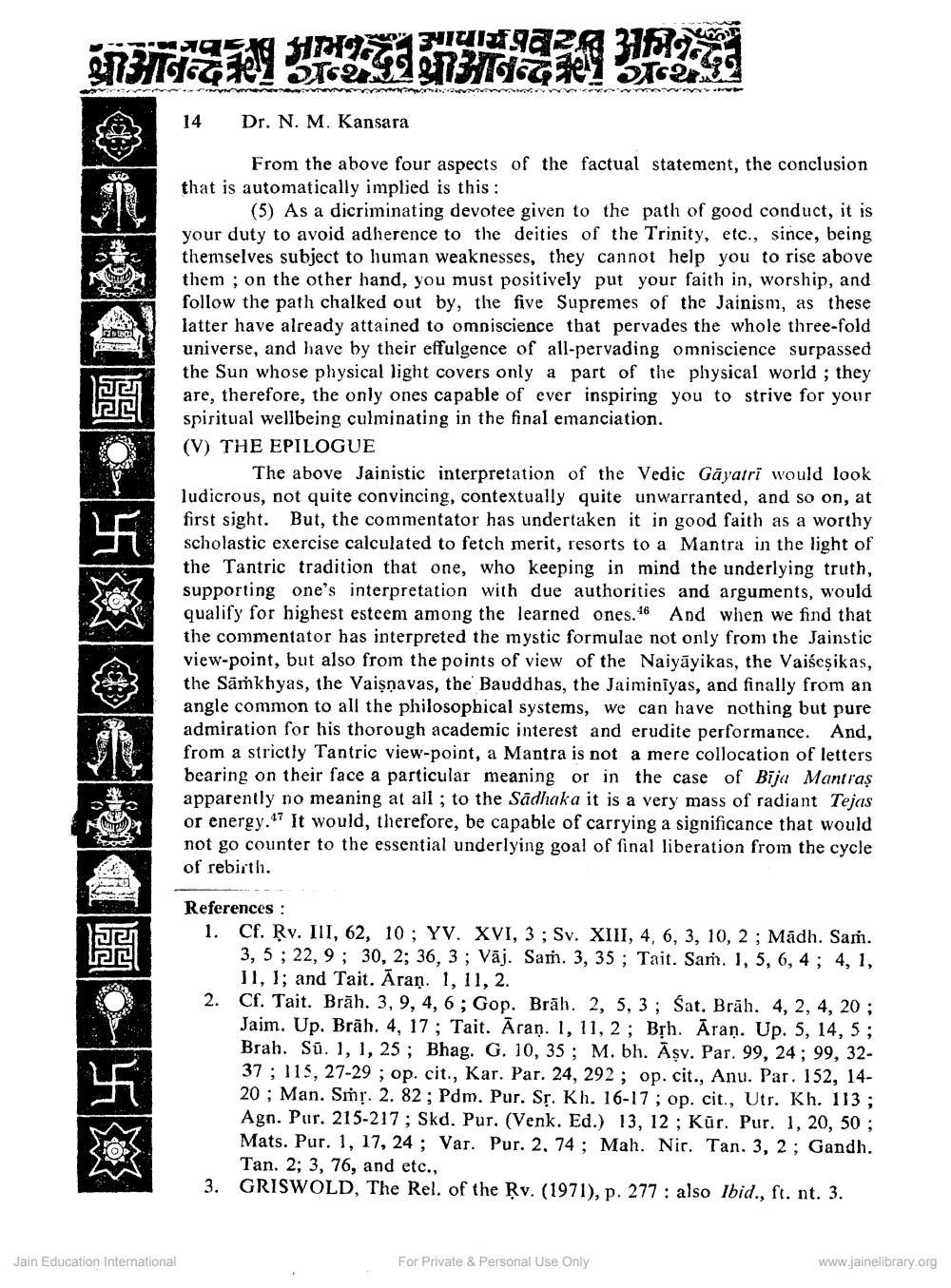________________
श्री आनन्दत्र ग्रन्थ SITHOLES
14
Dr. N. M. Kansara
疯
C
卐
th
Jain Education International
2131667 Ee
562
ocd
From the above four aspects of the factual statement, the conclusion that is automatically implied is this:
(5) As a dicriminating devotee given to the path of good conduct, it is your duty to avoid adherence to the deities of the Trinity, etc., since, being themselves subject to human weaknesses, they cannot help you to rise above them; on the other hand, you must positively put your faith in, worship, and follow the path chalked out by, the five Supremes of the Jainism, as these latter have already attained to omniscience that pervades the whole three-fold universe, and have by their effulgence of all-pervading omniscience surpassed the Sun whose physical light covers only a part of the physical world; they are, therefore, the only ones capable of ever inspiring you to strive for your spiritual wellbeing culminating in the final emanciation.
(V) THE EPILOGUE
The above Jainistic interpretation of the Vedic Gayatri would look ludicrous, not quite convincing, contextually quite unwarranted, and so on, at first sight. But, the commentator has undertaken it in good faith as a worthy scholastic exercise calculated to fetch merit, resorts to a Mantra in the light of the Tantric tradition that one, who keeping in mind the underlying truth, supporting one's interpretation with due authorities and arguments, would qualify for highest esteem among the learned ones. 46 And when we find that the commentator has interpreted the mystic formulae not only from the Jainstic view-point, but also from the points of view of the Naiyayikas, the Vaisesikas, the Samkhyas, the Vaisnavas, the Bauddhas, the Jaiminiyas, and finally from an angle common to all the philosophical systems, we can have nothing but pure admiration for his thorough academic interest and erudite performance. And, from a strictly Tantric view-point, a Mantra is not a mere collocation of letters bearing on their face a particular meaning or in the case of Bija Mantras apparently no meaning at all; to the Sadhaka it is a very mass of radiant Tejas or energy. It would, therefore, be capable of carrying a significance that would not go counter to the essential underlying goal of final liberation from the cycle of rebirth.
47
For Private & Personal Use Only
References:
1. Cf. Rv. III, 62, 10; YV. XVI, 3; Sv. XIII, 4, 6, 3, 10, 2; Madh. Sam. 3,5 22,9 30, 2; 36, 3; Vaj. Sarh. 3, 35; Tait. Sam. 1, 5, 6, 4; 4, 1, 11, 1; and Tait. Aran. 1, 11, 2.
2. Cf. Tait. Bräh. 3, 9, 4, 6; Gop. Brah. 2, 5, 3; Sat. Brah. 4, 2, 4, 20 Jaim. Up. Bräh. 4, 17; Tait. Aran. 1, 11, 2; Brh. Aran. Up. 5, 14, 5; Brah. So. 1, 1, 25; Bhag. G. 10, 35; M. bh. Asv. Par. 99, 24; 99, 3237 115, 27-29; op. cit., Kar. Par. 24, 292; op. cit., Anu. Par. 152, 1420 Man. Sbr. 2. 82; Pdm. Pur. St. Kh. 16-17; op. cit., Utr. Kh. 113; Agn. Pur. 215-217; Skd. Pur. (Venk. Ed.) 13, 12; Kür. Pur. 1, 20, 50; Mats. Pur. 1, 17, 24; Var. Pur. 2, 74; Mah. Nir. Tan. 3, 2; Gandh. Tan. 2; 3, 76, and etc.,
3. GRISWOLD, The Rel. of the Rv. (1971), p. 277: also Ibid., ft. nt. 3.
www.jainelibrary.org




